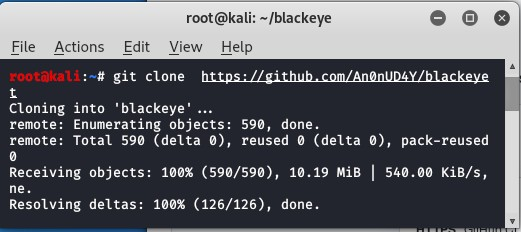Ever wondered how cybercriminals trick people into giving away their sensitive information? Phishing is one of the most common techniques used, and understanding how it works can help you protect yourself from these attacks. In this tutorial, we'll demonstrate how to install and use BlackEye on Kali Linux to create fake login pages, revealing the tactics used by hackers.
Remember, this is for educational purposes only and should be used responsibly to enhance your cybersecurity awareness.
Table of Contents
Topic Overview
In this guide, we will cover:
- Understanding BlackEye
- Installing BlackEye on Kali Linux
- Using BlackEye for phishing simulations
What is BlackEye?
BlackEye is a tool designed to create fake login pages, which hackers use to perform phishing attacks. Phishing involves tricking users into entering their credentials on these counterfeit pages, thereby capturing sensitive information. This tool is popular among hackers for its simplicity and effectiveness, especially when used in Kali Linux, a widely used platform for penetration testing and security research.
Now that you have a basic understanding of what BlackEye is, let me walk you through how it works and how you can set it up on your Kali Linux system.
Step 1: Clone the BlackEye Repository
First, you need to open your Kali Linux terminal. To install BlackEye, use the following command to clone the repository from GitHub:
git clone https://github.com/thelinuxchoice/blackeye
This command downloads the BlackEye tool to your system. The repository contains all the files necessary to run the BlackEye tool.
Step 2: Navigate to the BlackEye Directory
Once the cloning process is complete, navigate to the BlackEye directory using these commands:
cd blackeye ls
The cd command changes your directory to the BlackEye folder, and
the ls command lists all the files in that directory. You should
see a file named blackeye.sh among other files.
Step 3: Run BlackEye
Now, you need to run the BlackEye tool. Use the following command to execute the tool:
bash blackeye.sh
This command starts the BlackEye script. You will see a menu with various phishing options for different websites like Facebook, Google, Instagram, and more.
Using BlackEye for Phishing
After successfully installing BlackEye, you can perform a phishing attack by selecting an option from the menu. For example, to create a phishing link for Instagram, choose option 1.
1
After creating phishing links with BlackEye, send these links to your victims. When the victim enters their login credentials, the details will be displayed in the terminal.
When the victim enters their login information on the phishing page, their details are submitted.
After the victim submits their details, you can view their credentials in the terminal.
To capture Google account credentials using BlackEye, follow these steps:
Select option 6 from the BlackEye menu to create a Google phishing page:
6
Send the generated ngrok link to the victim. When the victim enters their account details, the information will be displayed in the terminal.
After the victim enters their details, you will see the tool capture their credentials.
Similarly, you perform experiments using the blackeye tool. The tool is free to use.
Related Posts
Protecting Against Phishing Attacks
While tools like BlackEye demonstrate how phishing attacks can be carried out, it's crucial to know how to protect yourself from such threats. Here are some effective ways to safeguard your information:
1. Use a VPN (Virtual Private Network)
A VPN encrypts your internet connection, making it harder for attackers to intercept your data. By masking your IP address and location, VPNs provide an additional layer of security and privacy. Consider using reputable VPN services to protect your online activities.
2. Enable Two-Factor Authentication (2FA)
Two-factor authentication adds an extra layer of security to your accounts by requiring a second form of verification in addition to your password. This can be a code sent to your mobile device or an authentication app. Even if a hacker obtains your password, they won't be able to access your account without the second factor.
3. Be Cautious of Unsolicited Emails and Links
Phishing attacks often come through emails or messages that urge you to click on a link or download an attachment. Always verify the sender's identity and avoid clicking on suspicious links or downloading files from unknown sources. Look out for red flags such as spelling errors, unusual email addresses, and urgent calls to action.
4. Use Anti-Phishing Software
Many antivirus and internet security programs offer anti-phishing features that can detect and block phishing attempts. Ensure your security software is up to date and enabled to provide real-time protection against malicious websites and emails.
5. Educate Yourself and Others
Staying informed about the latest phishing techniques and educating others can significantly reduce the risk of falling victim to these attacks. Participate in cybersecurity awareness training and share your knowledge with friends, family, and colleagues.
6. Verify Website URLs
Before entering your login credentials on a website, check the URL carefully. Phishing sites often use URLs that mimic legitimate websites but may have slight variations or misspellings. Ensure the website uses HTTPS, indicated by a padlock icon in the address bar, which signifies a secure connection.
7. Regularly Update Your Software
Keeping your operating system, browser, and applications updated ensures you have the latest security patches and protections. Regular updates can fix vulnerabilities that hackers might exploit to launch phishing attacks.
8. Use Strong, Unique Passwords
Use complex and unique passwords for each of your accounts. Avoid using easily guessable information like birthdays or common words. Consider using a password manager to generate and store strong passwords securely.
Conclusion
Phishing attacks are a prevalent and dangerous threat in today's digital world, but by taking proactive steps, you can protect yourself and your sensitive information. Using tools like VPNs, enabling two-factor authentication, being vigilant about emails and links, and educating yourself on the latest phishing tactics are all crucial in safeguarding against these attacks. By staying informed and implementing these security measures, you can significantly reduce your risk of falling victim to phishing scams.
If you found this guide helpful, please share it on your social media to help others stay informed and secure. Also, feel free to leave a comment below with your thoughts, questions, or additional tips on how to protect against phishing attacks. Your feedback and engagement are always appreciated!
FQAs
What is BlackEye?
BlackEye is a tool used to create fake login pages for phishing attacks. It helps hackers capture sensitive information like usernames and passwords by tricking users into entering their credentials on these counterfeit pages.
How can I install BlackEye on Kali Linux?
To install BlackEye on Kali Linux, open your terminal and use the command git clone https://github.com/thelinuxchoice/blackeye. Then, navigate to the BlackEye directory using cd blackeye and run the tool with bash blackeye.sh.
How do phishing attacks work?
Phishing attacks involve creating fake login pages that look like legitimate sites. Victims are tricked into entering their credentials on these pages, which are then captured by the attacker. BlackEye automates this process by providing pre-designed phishing templates.
How can I protect myself from phishing attacks?
To protect yourself from phishing attacks, use a VPN, enable two-factor authentication, be cautious of unsolicited emails and links, use anti-phishing software, verify website URLs, and regularly update your software. Educating yourself and others about phishing techniques is also crucial.
Is it legal to use BlackEye for phishing?
Using BlackEye or any other tool for unauthorized phishing attacks is illegal and punishable by law. It is important to use such tools responsibly and only for educational purposes or authorized security testing.










